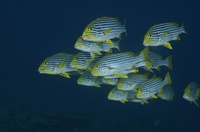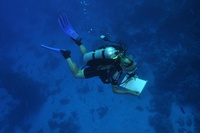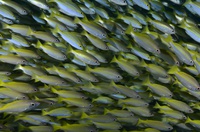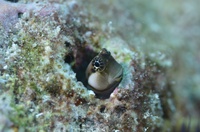Marine biodiversity
Redmap Team & Dr Rick Stuart-Smith.
Biodiversity is the degree of variation of life, and can refer to genetic, species or ecosystem variation. Here we talk a little about what diversity is, how it can be measured, and include a few interesting stats!
-
Did someone say diversity? (Oriental sweetlip, Plectorhinchus vittatus. Image credit: Adam Duraj)
-
Counting species (Image credit Rick Stuart-Smith, Reef Life Survey)
-
High abundance.....low diversity (Bigeye snapper, Lutjanus lutjanus; Seychelles) (Image credit: Adam Duraj)
-
Diversity can be hard to count...(Blenny, Ecsenius spp. Maldives (Image credit: Adam Duraj)
Biodiversity, or biological diversity, is a term that captures the variety of life at all levels, including species, genes, habitats and even ecosystems. Most often though, we tend think of biodiversity as species diversity, which is something we can most easily see and value. But species diversity can be calculated in different ways – mostly differing in what is considered as the base unit. For example, the most basic level of species diversity is species richness, which is simply the number of species in a sample or found in a region altogether. But instead of thinking of species as the base unit, species diversity can be calculated considering individuals as the base unit – where higher diversity reflects a greater chance that the next individual you see will be of a different species to the last. For example, if 90% of the individuals in an area are of a single species (i.e. it has higher relative abundance), the diversity will be relatively low – since most individuals you see will be that one species.
Why diversity is important: to maintain natural functioning/health of ecosystems (which has flow-on effects for being able to cope with environmental change, pest species and other unfavourable impacts).
How species richness is measured: It’s harder than you think! It’s virtually impossible to count all of the species on the planet, or even a small part of the world (and harder for marine systems than on land). Scientists usually sample a small area very thoroughly and can estimate how many species might be present that they have not found yet by counting the number of new species they find in each sample. When additional samples will stop turning up new species, then they can be confident they have found most of the species present in that area.
The number of species at a particular location is referred to as alpha diversity. Beta diversity is the difference in species between these particular locations. The total species diversity in a larger region (i.e. made up of these smaller locations) is determined by both the alpha AND beta diversity (and is called gamma diversity). It is possible to have high beta diversity without high alpha diversity though, for example, if each location were to have a small number of completely different species.
Some marine statistics: So how many marine species are there in Australia? Good question! The answer is a little tricky... but in 2012, the Census of Marine Life estimated there were 2.2 million species in the world’s oceans (….give or take a couple hundred thousand). For the marine world, this estimate means that 91% of marine species are yet to be discovered or described (Mora et al, 2011)…. The World Register of Marine species lists over 459,000 described marine species worldwide…so there’s still a lot we don’t know!
Here are a few other interesting Australian marine statistics we found:
- 4000+ marine fish species (~2000 on the Great Barrier Reef!)
- 45 species of cetaceans (whales, dolphins, porpoises) live in or migrate through our waters
- 19 albatross species (of a total of 24 throughout the world)
- 166 species of shark (over 300 cartilaginous fishes)
- Reptiles: over 30 species of sea snakes, 6 species of marine turtles (7 worldwide), and 1 species of saltwater crocodile inhabit Australian waters
- Australian marine invertebrates:
- 1000+ species of echinoderms (e.g. urchins and sea stars)
- 200+ species of sea spiders
- 1500+ species of jellyfish, sea anemone, corals
Some other interesting (global) statistics:
- The smallest marine fish is the stout infantfish (Schindleria brevipinguis) which is native to the Great Barrier reef, and grows to just over 8mm .....However, males of another species (Photocorynus spiniceps) only grow ~ 6mm long…. But females are much larger (50mm). The males are parasitic (spend their life attached to the female!)
- The whale shark (Rhincodon typus) is the largest fish in the sea (up to 14m long)
- Blue whales (Balaenoptera musculus) are the largest creatures – over 30m &180 tons
- Longest lived animal…is black coral! In 2009, scientists studying deep-sea corals discovered specimens of Leiopathes to be among the oldest continuously living organisms on the planet: approx 4,265 years old! With some members found in Australia (see Atlas of Living Australia)
- Orange roughy (Hoplostethus atlanticus) are among the longest living marine fish (~150 years old)
References/further reading can be found HERE















